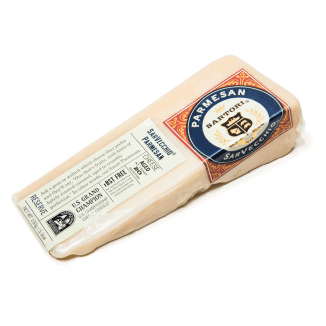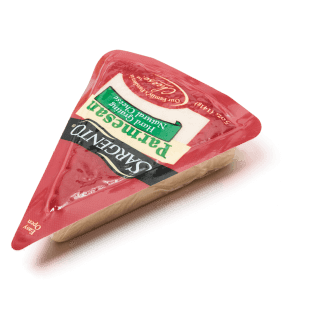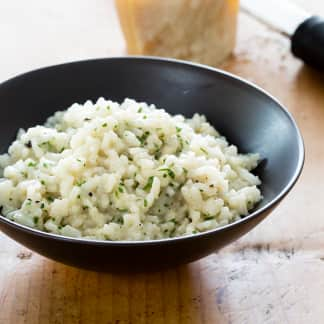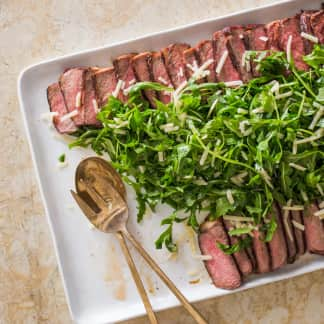There’s a heated debate raging in the cheese world. On one side, Parmigiano-Reggiano, the so-called king of cheese. Complex, with fruity, nutty, savory notes; a dry, crumbly texture; and a crystalline crunch, this cheese has been made in precisely the same way in northern Italy for the past 800 years. Its adversary? Imitators like Parmesan, Parmezan, Regginito—takes on the classic made under varying regulations in the United States and around the world. (We’ll refer to this group of cheeses simply as “Parmesan” from here on out.) Parmigiano-Reggiano producers want clearer labeling to call out these imitators. The European Union and the United States are currently debating how to label cheese as part of a massive trade agreement.
But nomenclature aside, how’s the cheese? Do the imitators actually rival the real thing, or are their knockoff names where the similarity ends? To find out, we chose the top seven nationally available supermarket products—five domestic Parmesans and two certified Parmigiano-Reggianos from Italy. We asked 21 tasters to evaluate them plain at room temperature and cooked in polenta. We sent samples of each cheese to an independent laboratory for evaluation.
Even before tasters took a bite, differences among the cheeses were noticeable. On the whole, domestic products were smoother, almost waxy in appearance; the two Parmigiano-Reggianos appeared drier and had visible white flecks of crystallization. In the plain tasting, tasters in general panned the domestics, criticizing them for being rubbery and bland. The two Parmigiano-Reggianos, on the other hand, earned praise for being dry and crumbly, with flavor that was “robust,” “nutty,” and “clear and bright.” While the textural differences didn’t come out as clearly in the polenta tasting, the preference for the imports held up. But when we took a closer look at the results, we noticed that one domestic cheese fared impressively well, earning praise for both its flavor and texture. It even had those crystalline flecks.
So what are these producers doing differently? For an explanation, we looked into how the cheeses are made, starting with the cows and what they eat.
From Cow to Wheel
In the highly sanctioned world of Parmigiano-Reggiano, cows graze in pastures; their diet must consist of at least 75 percent local grass. Here in the United States, the U.S. Food and Drug Administration (FDA) doesn’t mandate diet, and cows typically aren’t pastured; manufacturers reported using various feeds, including hay, corn, soybeans, and grains.
According to Dean Sommer, cheese and food technologist at the University of Wisconsin’s Center for Dairy Research, diet has a major effect on the flavor of the cheese. Pastured cows that feed mostly on fresh grass and various other naturally growing plants tend to have more complexly flavored milk than those with grain-based diets.
Another factor: raw versus pasteurized milk. In Italy, Parmigiano-Reggiano is always made from raw milk. In the States, the milk is typically pasteurized first. This step kills off potentially dangerous organisms and yields a more consistent product. The downside? The heating process also kills off flavorful microorganisms.
Fat content plays a role as well. Before the milk is made into cheese, some of the milk fat is skimmed off, but that amount can vary. Our lab reports showed that the Italian cheeses contain more fat than the domestics. Fat equals flavor, and our tasters enthusiastically approved of cheeses that had more of it.
To make the cheese, milk is warmed and combined with a starter culture to kick off the curdling process. Then rennet (enzymes that further facilitate curd formation) goes in. The mixture is stirred to evaporate some moisture, the curds are formed into wheels, and the wheels go into salt baths for preservation and flavor. There’s one key difference in this stage: Domestic wheels range in size from 20 to 24 pounds, while wheels of Parmigiano-Reggiano weigh at least 66 pounds. Domestic producers make smaller wheels for various reasons, including that they’re easier to work with, age faster, and result in a smoother cheese that’s easier to slice into uniform wedges. Smaller wheels also pull in salt faster than larger ones because they have more exposed surface area. Our lab results confirmed this: The domestic cheeses had an average of 40 percent more sodium than the Italian cheeses. We typically prefer saltier products, but in this case manufacturers seem to be using the salt to flavor otherwise very bland cheeses—which would explain why tasters found that the domestic cheeses on the whole had simple savory notes at best.
Aged to Perfection
The aging step affects both flavor and texture. Once the wheels come out of the salt bath, they’re set on racks in climate-controlled rooms to age. As the cheese sits, lactic acid forms, and the acid causes proteins in the cheese to squeeze together, which in turn forces out moisture. Parmigiano-Reggianos are required to age for at least 12 months, though most are left for 24. Meanwhile, the FDA mandates a minimum of just 10 months for Parmesan. Thus, the domestic cheeses tended to be rubbery, while the imports were dry and crumbly. Lab results backed this up, showing that the domestic cheeses had an average of 34.61 percent moisture, while the imports averaged 30.11 percent. Interestingly, according to the FDA, domestic Parmesans must contain no more than 32 percent moisture, yet our lab results showed three products above that limit, at 35.62, 36.49, and 37.99 percent—a significant difference, according to industry experts. These higher levels could be attributed to natural variation among batches, attempts to eke out a bit more product, a bid to boost flavor since more moisture can make flavor develop faster early in the process, or a goal of making a cheese that melts and grates better.

To that point, we discovered that the cheese with the highest moisture content in the lineup—Sargento Hard Grating Parmesan—is a different type of cheese altogether under FDA regulations. Cheeses categorized as “hard-grating” require less aging and allow for more moisture. It’s no surprise that this product fell near the bottom of our rankings.
As the cheese ages, enzymes from the starter culture and rennet continue to break down the cheese at the molecular level. Complex fats are broken down into individual free fatty acids, which give the cheese a sharp flavor. They also convert into aromatic compounds called esters when they combine with naturally present alcohols, contributing a layer of fruitiness. The enzymes break down proteins in the cheese into shorter peptides and individual amino acids, both of which give the cheese its appealing nuttiness. Sommer called this process “a giant Scrabble game in reverse.” The more time allowed for these reactions to occur, the more flavor there will be, so not surprisingly, tasters liked older cheeses. At 24 months, our winner was the oldest in the lineup.
See the Difference

Waxy Wannabe
A telltale smooth, waxy texture identified last-place Belgioioso as a domestic Parm.

Crumbly Champ
Our imported winner, from Boar’s Head, boasts Italian Parm’s trademark crystalline flecks and dry texture.
These enzymatic reactions are also responsible for those crunchy, appealing crystals. Over time, some of the peptides continue to break down into individual amino acids. Two amino acids, tyrosine and leucine, become visible as white crystals and larger white pearls, respectively. The younger domestic cheeses had few, if any, noticeable crystals or pearls, while the two older Parmigiano-Reggianos had constellations of them.
Could It Be a Contender?
Considering the whole picture, all the way from feed to aging, it’s clear why so many domestics don’t measure up. But what about that one that came close? Our third-place cheese, Sarvecchio, is made in Wisconsin and aged for at least 20 months, twice as long as its domestic counterparts. Its manufacturer also reported the most varied feed. It didn’t quite have the depth the Parmigiano-Reggianos had—it’s aged four months less than our winner, doesn’t have the same diet regulations, and is made with pasteurized milk—but we think it deserves a nod as a good domestic option. If domestic producers—or producers anywhere—were to follow more of the Parmigiano-Reggiano specifications, we think they could make a comparable cheese.
But for now, for that classic, craggy, crystalline cheese with elegant depth, you still have to look to a roughly 8,500-square-mile patch of land in northern Italy. You’ll pay a higher price for the quality exacted by Parmigiano-Reggiano regulations— most domestic Parms were half its price. But because of its fuller flavor, you can use it more sparingly. Our winner is sold by Boar’s Head, an American company that purchases Parmigiano-Reggiano and sells it under its name. Tasters were unanimous, voting Boar’s Head Parmigiano-Reggiano the best supermarket Parmesan of all the products we sampled.
- Sample plain at room temperature
- Sample in Creamy Parmesan Polenta
- Dry, crumbly texture
- Lots of crunchy tyrosine crystals
- Complex flavor: savory, sharp, nutty, fruity, and rich
- Aged at least 18 months




















